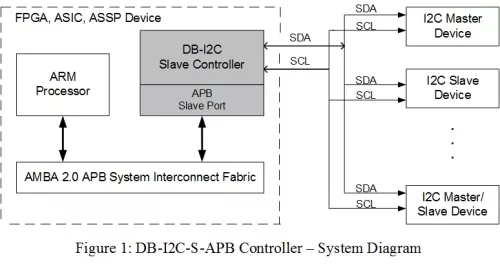The Digital Blocks DB-I2C-S-APB Controller IP Core interfaces an ARM, MIPS, PowerPC, ARC or other high performance microprocessor via the AMBA 2.0 APB System Interconnect Fabric to an I2C Bus. The I2C is a two-wire bidirectional interface standard (SCL is Clock, SDA is Data) for transfer of bytes of information between two or more compliant I2C devices.
The DB-I2C-S-APB is a Slave I2C Controller that controls the Transmit or Receive of data to or from external Master I2C devices. Figure 1 depicts the system view of the DB-I2C-S-APB Controller IP Core embedded within an integrated circuit device.
I2C Slave Controller w/FIFO (APB Bus)
Overview
Key Features
- I2C Slave Controller - Implements Slave-only protocol for smaller VLSI footprint, for applications requiring Slave–Receiver and Slave–Transmitter capability
- SCL Clock only for low power, low noise applications requiring configuration & management of User Registers
- 7- or 10-bit addressing, General Call, SCL Low Wait States
- Supports five I2C bus speeds:
- Standard mode (100 Kb/s)
- Fast mode (400 Kb/s)
- Fast mode plus (1 Mbit/s)
- Ultra fast mode (5 Mbit/s)
- Hs-mode (3.4 Mbit/s)
- Compliance with I2C specifications:
- Philips – The I2C-Bus Specification, Version 2.1, January 2000
- NXP Rev .5 October 9, 2012
- Fully-synchronous, synthesizable Verilog RTL core. Easy integration into FPGA or ASIC design flows.
Block Diagram

Deliverables
- Verilog RTL Source or technology-specific netlist.
- Comprehensive testbench suite with expected results.
- Synthesis scripts.
- Installation & Implementation Guide.
- Technical Reference Manual.
Technical Specifications
Foundry, Node
Chartered, Global Foundries, Intel, LSI. OKI, Silterra, SMIC, STMicroelectronics, Tower, TMSC, UMC
Maturity
Successful in Customer Implementations
Availability
Immediately
Related IPs
- I2C Master / Slave Controller w/FIFO (APB Bus)
- I2C Slave Controller w/FIFO (APB or AHB or AHB-Lite or AXI-Lite Bus)
- I2C Master Controller w/FIFO (APB Bus)
- I2C Master / Slave Controller w/FIFO (AXI & AXI-Lite Bus)
- I2C Master / Slave Controller w/FIFO (AHB & AHB-Lite Bus)
- SPI Master / Slave Controller w/FIFO (APB Bus)